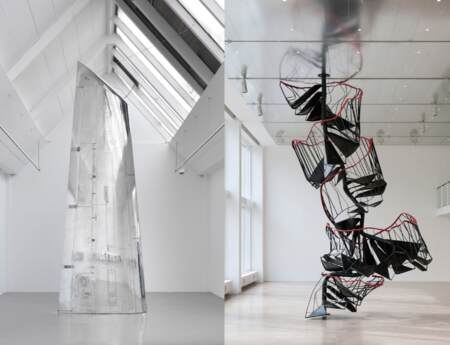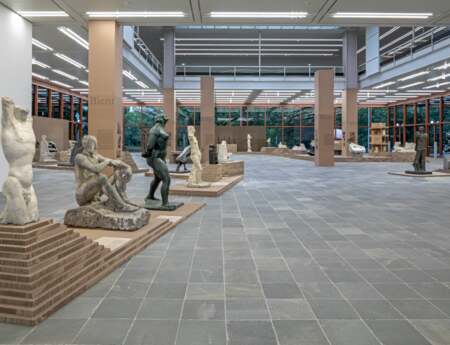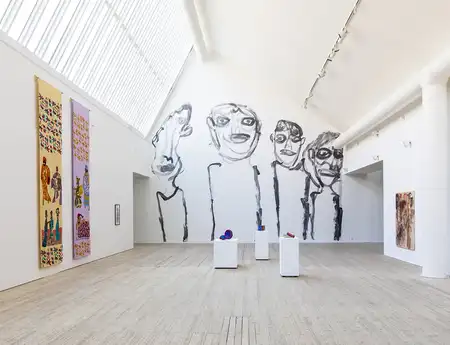Centro Andaluz de Arte Contemporáneo
C. Américo Vespucio 2
41092 Sevilla
Spanien
Amie Siegel. Quicksand
Amie Siegel: Quicksand brings together a selection of the artist’s work across multiple mediums— film, photography, painting, sculpture—that address deep time and the evolving ecologies and economies of our material world. The first survey of Amie Siegel’s work in Spain, this exhibition was created in dialogue with the Centro Andaluz de Arte Contemporáneo’s historical spaces and the traces of materiality, labor and belief therein— connecting the CAAC’s former life as a 12th century Carthusian monastery, and 19th century porcelain tile factory to the concerns of the present.
Quicksand invites viewers to traverse an increasingly fractured path across human and geological time, navigating elements of sand, water, gold, and marble, from a vast cosmic dimension to tiny desert particles inside an hourglass. The constellation of works across the museum’s spaces exposes the invisible threads linking layers of circulation, economic fluctuation, and processes of constructing value, highlighting the artist’s characteristic deployment of matter and media that mirror the behaviours of the system they describe.
The artist’s multichannel video installation Asterisms (2021), presented at monumental scale in the former church’s altar, forms the core of the exhibition. Asterisms explores geological and social displacement on a planetary scale, focusing on the United Arab Emirates. Gold factories, oil recovery, artificial islands and the migrant labor that sustains them are among the elements that unfold in different, often overlapping, cinematic geometries projected onto a star-like shape that hovers between a wall and a sculpture.
The floating, panoramic film projection Quarry (2015) traces the source of marble from a dark, cave-like underground quarry in Vermont to its high-end destinations in Manhattan developments. White marble, with its association to classical sculpture, is here shaped and constructed into the interior surfaces of these luxury apartments, designed to bring even the most mundane spaces in closer proximity to the materiality and value of art. Ultimately the representation of living, or life, exposes a complex economy of production and speculation.
The sculptural installation Dynasty (2017) orbits around a fragment of pink marble from the lobby of New York’s Trump Tower. Offered for sale on eBay following the 2016 US presidential election, the marble fragment was purchased by the artist. The elements of display that make up the resulting work—the vitrined marble relic, its provenance, a photographic diptych of book-matched marble and the ebay seller’s evidentiary photograph— together raise questions of authenticity and belief; materiality and ideology.
In Surrogates (2016), fragments, classical sculpture and museological perspectives also evidence in marble. Placed near the cloister’s architectural remnants and the marble tombs of the small chapel, this continuous slide projection presents moments of rupture and repair on the bodies of ancient sculpture in the Naples National Archaeological Museum.
Siegel’s Marble Dust Paintings (2019) are a group of works made from marble dust– the sediment, water and vapor thrown off by the vast marble cutters that appear in her film Quarry. This ‘remaindered’ material, a milky sediment that dries into a fine powder, is a key ingredient of painting primers. Here Siegel considers how marble dust, a material from the medium of classical sculpture, becomes the sub-strata of the medium of painting. Her paintings are both autonomous works of art, and reproductions of the systems she considers. They continue modern art’s interest in chance compositions— in this case the patterns created by the motions of mining machinery— and also her own investigations of how value accrues in the art market, and how the mundane can be transmuted into the precious. Siegel’s paintings perform a comparable alchemical act, transforming discarded dust into precious fine art.
Listening to the Universe (2014) is a work on paper derived from the artist’s collection of science museum postcards, presenting the vacuum of sound that is outer space, and our continual efforts to listen, or know, our sphere and beyond. This discreet suggestion to be present is returned to in the artist’s new sculptural work, a group of Hourglasses (2025)—that condense the duration of a film loop, the movement of matter and the fragility of elements in their urgent reflection on time.
Throughout the exhibition we are invited to witness natural resources converted into belief systems and tools of power. The tension between the latent violence of the social themes exposed and the elegance of their presentation is a key aspect of Siegel’s work, a transfiguration of meaning, scale and elements that ultimately reflects our human, planetary condition.
BIO
Amie Siegel (b. 1974, Chicago, IL) is a visual artist working variously with film, video, photography, sound, performance and installation.
Recent solo exhibitions include Asterisms, VISUAL Centre for Contemporary Art, Carlow, Ireland (2024); Amie Siegel: Panorama, Carnegie Museum of Art, Pittsburgh (2023); Bloodlines, Scottish National Museum Gallery of Modern Art (2022); The Silence, ArkDes, Stockholm (2022); Medium Cool, Blaffer Art Museum, Houston (2019); In Focus: Amie Siegel – Provenance, Tate St. Ives (2018); Winter, Guggenheim Museum Bilbao (2017); Strata, South London Gallery (2017); Double Negative, Museum Villa Stuck, Munich (2016) and Ricochet, Kunstmuseum Stuttgart (2016). She has participated in the 34th São Paulo Bienal, 12th Gwangju Biennial; Dhaka Art Summit, Bangladesh; Glasgow International, Scotland; 5th Auckland Triennial, New Zealand; and the Whitney Biennial including numerous other group exhibitions.
Siegel’s films have screened at the Cannes, Berlin, Toronto, Rotterdam and New York film festivals. Her work is in the permanent collections of The Museum of Modern Art, New York; Tate, London; The National Galleries of Scotland, Edinburgh; The Art Institute of Chicago; Kunstmuseum Stuttgart; Auckland Art Gallery, New Zealand; MAK-Museum für Angewandte Kunst, Vienna; The Metropolitan Museum of Art; Whitney Museum and Solomon R. Guggenheim Museum, New York. She has been a fellow of the DAAD Berliner-Künstlerprogramm and Guggenheim Foundation, the Fulton Fellow at The Film Study Center at Harvard University and a Smithsonian Artist Fellow. Siegel has received numerous grants and awards including from the Sundance Institute, Princess Grace Foundation, ICA Boston (Foster Prize), Creative Capital, Anonymous Was a Woman and the Foundation for Contemporary Arts, New York.


